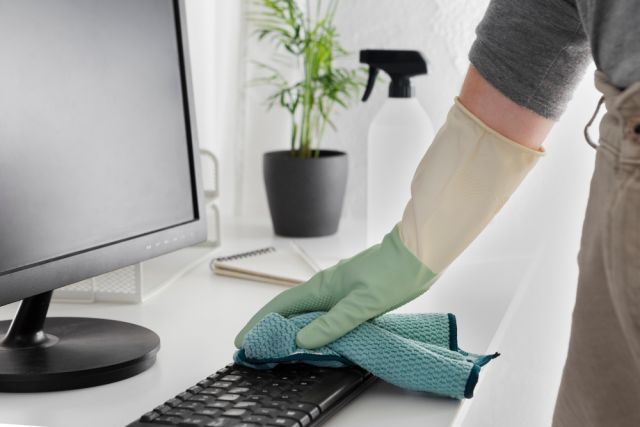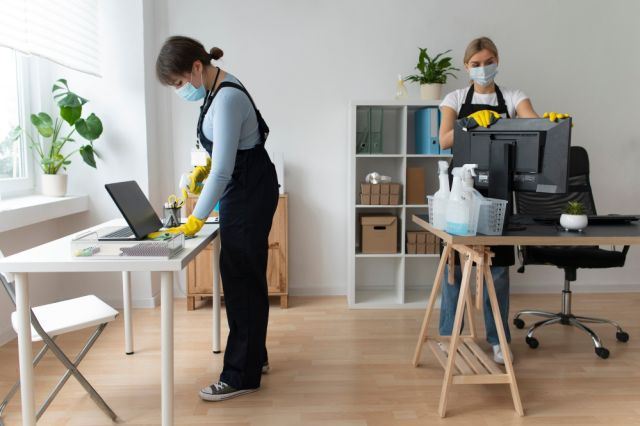Innovations In Commercial Cleaning Sector

Traditionally, commercial cleaning has been a conservative industry and a slow adopter of technology -up until now.
The COVID-19 pandemic and other drivers have accelerated the adoption of innovation within the commercial cleaning sector. Over the past few years, cleaning innovations have surpassed the growth of many sectors combined(1), in terms of their increased reliance on technology, improved integration of AI and automated cleaning equipment, and even in terms of the advancements of the supplies used. These changes have ‘shaken up’ the sector and have generated vastly improved efficiencies, sustainability, safety and more effective cleaning practices.
In this blog, we look at some of the recent innovation areas in the commercial cleaning sector, and how they have improved outcomes for customers. We also take a ‘sneak peak’ into the future of some emerging technologies that will further revolutionise the sector.
Major Innovations in the Commercial Cleaning Sector:
- High Tech Cleaning
Cleaning today is no longer just a ‘mop and bucket’ routine – it is highly sophisticated. Traditional cleaning equipmentis much more advanced, delivering greater cleaning consistency and efficiency, increased cleaner safety (by being lighter weight and more economic), and improved cleaning results.As one example, some of the newer orbital scrubbing technologies have been carefully engineered to be able to strip floors, eliminating the need for conventional, more toxic stripping methods. Such scrubbers can be used on nearly every surface, use minimal water and no detergents (5).
AI-powered vacuuming and scrubbing robots are also increasingly used in numerous industries and environments. The autonomous robots are programmed and run to a mapped path, reducing cleaning time and costs. While robots today predominantly clean floors, in the future we will see them perform more complex tasks, such as polishing, dusting, cleaning toilets etc. In the future we might also see exoskeletons(wearable robotic devices) adopted in the cleaning industry, that can reduce work-relatedrepetitive injuries.(3) Between 2020 to 2026, the cleaning robot market is expected to grow by 22.9% to reach USD $24 billion (4).
Just like robotics technology, drone technology is also being increasingly used in the cleaning industry. They are used to clean hard-to-access areas, such as high-rise windows, roofs, gutters, solar panels etc. Drones will be increasingly used by commercial cleaners in the future as a cost-effective solution to efficiently and safely clean difficult areas.
- Going Totally Green
With the intensifying climate crisis, green cleaning solutions are more prevalent in the domestic and commercial markets.While green cleaning has been around for a while, the industry has‘upped the ante’ in recent years with new technologies to facilitate a lower-impact service.
Today there are a wide range of non-toxic, chemical-free cleaning solutions. There is an abundance of multi-functional steam-based equipment and appliances for example, providing excellent sanitation.Commercial cleaners are also increasingly using engineered ionized water products, such as Z-Water used by GJK. This product is 100% chemical free, biodegradable and is dispensed in refillable bottles – substantially reducing wastage and transportation impacts. Indeed, with the transportation of cleaning products being major contributor to the sector’s GHG emissions, future innovations – such as compressed dissolvable cleaning tablets – may also become a popular eco-option (4).
Technology has also been applied to a variety of waste solutions, to lower waste-to-landfill.Larger cleaning companies use IOT-based waste-tech software to track waste streams, providing insights to make better waste decisions. A new‘circular economy’ approach to waste means that commercial cleaners are thinking innovatively about the regenerative capacity of products they buy and how to responsibly dispose of them. GJK for instance, actively sought a relationship with partnership with Simply Cups, who up cycle customer coffee cups into items of higher value for resell.
Overall, much of the cleaning equipment and tools today have vastly improved environmental credentials – using less energy and water and being able to effectively clean without detergents. The industry has also embraced electric-powered vehicles and equipment, lowering GHG emissions in their operations. Furthermore, there are some innovative product solutions to counter old unsustainable practices;one such innovation adopted by GJK for instance are TerraCyclic sanitary units that have a totally disposable and biodegradable ‘lid and liner’ cartridge system, with a compact design that reduces transportation impacts.
- Sanitization and Disinfection Solutions
Since the pandemic, we have become a world obsessed with sanitisation – and the commercial cleaning sector has responded with a host of new disinfection solutions.
We saw the introduction of Ultraviolet-C Technology (UVC) for instance, which is an energy-rich light that breaks apart viruses and bacteria. In commercial settings, it can be used to disinfect surfaces and the air, however it has a high risk-factor and needs to be used in closed spaces to protect users from UVC light exposure.
The pandemic also gave rise to the emergence of electroplastic sprayers, which mix disinfectant solutions with air, then apply an electric charge to them through an electrode inside the sprayer nozzle. Foggers and Misters, which emit tiny droplets of disinfectant, were also popular in the commercial sector to kill airborne and surface germs.
Another disinfecting technology included Antimicrobial Surface Protection Products, which provide long-lasting protection to the surface once applied. The solution creates a covalent bond with a positive electrical charge, which kills new microbes as they land (2). GJK uses such products to protect customers and provide ongoing surface sanitisation., such as the Zoono Microbe Shield Surface Sanitiser.
- Improved Workflows, Communication and Contract Transparency
Today, most largecommercial cleaners use integrated planning tools and apps for scheduling, organising and analysing the cleaning process. Work Management Systems have been around for a while, which enable task automation and visibility into work orders. Now however, we are witnessing the onset of IOT-enabled sensor technology as well, which gives unprecedented insights into building usage, so cleaning companies can tailor their cleaning regimes accordingly. Indeed, the Big Data generated from these systems mean they can deliver a highly efficient needs-based service. In the future, cleaners’ IOT systems may contribute to creating a buildings’ entire ‘digital ecosystem’, giving customer full insights into how the building is used for better decision-making and operational results.
New technologies mean commercial cleaners can also provide a highly transparent contracted service.Big companies, such as GJK, are providing customers with highly comprehensive all-in-one BI Powered Dashboards for instance, to see how the contract is performing in real-time. A range of cloud-based systems feed into this dashboard, generating important data for customers on a wide range of metrics such as work order management, safety incidents, sustainability results and more.
Conclusion: No longer is Commercial Cleaning a dinosaur industry. It has embraced technology on all fronts – particularly since the onset of the COIVD-19 pandemic. We are seeing an era of exciting change, with robotics, IOT, systems and radical new tools shaking up the industry. Not since the industrial revolution has the cleaning industry witnessed such fundamental changes influenced by technologies, and we can’t wait to see what is next!
References:
- Commercial Cleaning Innovations That Are Worthy | JBN Cleaning
- Technologies for commercial cleaning and disinfection (facilityexecutive.com)
- Will exoskeletons enter the cleaning industry? – Newsroom (fmnewsroom.com)
- Blueland delivers home cleaning products to your door as tablets (fastcompany.com)
- 6 Innovations In Industrial Cleaning That Are Worth A Try (healthtechzone.com)
- Advances in floor cleaning equipment | HFM | Health Facilities Management (hfmmagazine.com)




